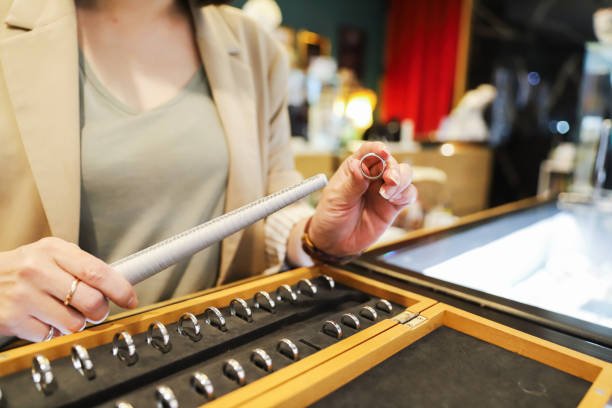Finding the perfect ring can be exciting—but one wrong size can turn joy into frustration. Whether it’s an engagement ring, wedding band, or a stylish accessory, knowing how to find ring size accurately ensures comfort and elegance. In this guide, we’ll walk you through easy, reliable methods, share expert tips, and answer common questions so you can shop or gift confidently.
Why Knowing Your Ring Size Matters
Choosing the right ring size isn’t just about aesthetics—it’s about comfort and practicality. Rings that are too tight can cause discomfort or even circulation issues, while rings that are too loose risk slipping off and getting lost. An accurate measurement ensures that your ring fits perfectly and looks its best.
Fun fact: The average ring size for women is 6–7, and for men, it’s 9–10. But finger sizes vary with age, weather, and even time of day, so measuring carefully is crucial.
H2: Methods to Find Your Ring Size
There are multiple ways to determine your ring size, from professional tools to DIY techniques. Here’s a breakdown:
H3: 1. Visit a Jeweler
The most reliable method is visiting a professional jeweler. Jewelers use a ring sizer set or a mandrel to measure your finger accurately. This method provides precision down to half or quarter sizes, which is especially important for engagement or custom rings.
Pro tip: Measure your finger later in the day when it’s slightly larger due to natural swelling. Avoid measuring in the morning, as fingers are usually smaller.
H3: 2. Use a Printable Ring Sizer
Many jewelry websites provide free printable ring sizers. You simply print, cut, and wrap around your finger. Make sure to print at 100% scale—any resizing can affect accuracy.
Step-by-step:
-
Print the sizer and cut it out.
-
Wrap it around your finger snugly.
-
Note where the end meets the sizer—this is your size.
Tip: Measure multiple times to ensure consistency.
H3: 3. Measure an Existing Ring
If you already own a ring that fits well, you can use it to determine size.
How to measure:
-
Place the ring on a ruler and measure the inner diameter in millimeters.
-
Compare this measurement with a ring size chart (available online) to find your size.
Important: Only measure rings worn on the correct finger because sizes differ between fingers.
H3: 4. String or Paper Method
For a simple at-home method, use a string or thin strip of paper:
-
Wrap it around your finger at the base.
-
Mark where the ends meet.
-
Measure the length with a ruler in millimeters.
-
Use a size chart to convert the length to a ring size.
Pro tip: Add 1–2 mm for comfort. This method is less precise but works in a pinch.
H2: Tips for Accurate Ring Sizing
Accurate measurement is key. Here’s what to consider:
-
Time of day matters: Fingers swell in heat or after physical activity.
-
Avoid measuring when cold: Fingers shrink in low temperatures, giving a smaller size.
-
Consider knuckle size: If your knuckle is larger than the base of your finger, measure both and choose a size in between.
-
Account for ring style: Wide bands may require a slightly larger size for comfort.
Example: If your finger measures size 6 for a thin band, a 6.5 might be more comfortable for a 10mm wide ring.
H2: Ring Size Conversions
Different countries use different sizing standards. Here’s a quick comparison:
| US | UK | EU | Diameter (mm) |
|---|---|---|---|
| 6 | L | 16.5 | 16.5 |
| 7 | N | 17.3 | 17.3 |
| 8 | P | 18.1 | 18.1 |
| 9 | R | 19.0 | 19.0 |
Tip: Always check conversion charts if buying internationally to avoid mistakes.
H2: Common Mistakes to Avoid
-
Guessing the size: Rings can’t be resized indefinitely, so guessing may lead to disappointment.
-
Ignoring finger fluctuations: Weight changes and weather affect sizing.
-
Measuring the wrong finger: Rings fit differently on each finger.
-
Not considering comfort: A snug fit is necessary, but too tight is uncomfortable.
H2: Expert Tips for Buying Rings Online
Shopping online? Here’s how to ensure a perfect fit:
-
Check if the retailer offers a free ring sizer.
-
Read reviews for guidance on sizing accuracy.
-
If in doubt, size up slightly—resizing down is easier than up.
-
Keep in mind your knuckle size for comfort with slip-on rings.
H2: Conclusion
Knowing how to find ring size is essential for anyone buying rings—whether it’s a gift or a personal treat. By using professional tools, at-home methods, or existing rings, you can ensure the perfect fit every time. Remember to consider time of day, finger fluctuations, and band width for maximum comfort. With these tips, your ring will not only look beautiful but feel perfect too.
H2: FAQs
1. Can my ring size change over time?
Yes, factors like weight changes, pregnancy, and age can affect finger size. It’s best to measure periodically.
2. What if my ring falls between sizes?
Choose the larger size for comfort, especially for wider bands.
3. Can I measure my finger in winter?
Avoid measuring in cold weather—fingers shrink, giving a smaller measurement.
4. Is it better to measure at home or at a jeweler?
Professional measurement is more accurate, but at-home methods are convenient and can be surprisingly precise.
5. How do I convert US ring sizes to EU sizes?
Use an international size chart; for example, US size 6 equals EU size 16.5.
